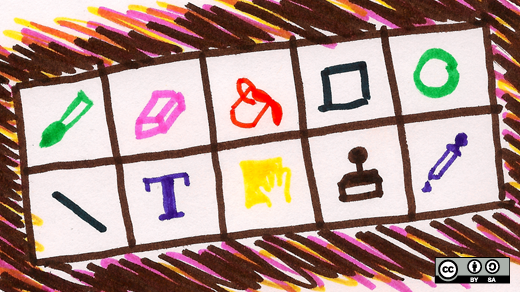I work at a public library with 28 Linux stations made publicly available in four separate rooms. The room in which I spend most of my time has 10 computers, and elementary and middle school students stop by daily after school to use them. About 90 percent of the children use the computers for games, and about 10 percent use them for doing homework. Very few use the computer for creative graphics applications. I'm bent on changing that.
Our computers run three very interesting, fun, and useful graphics programs. For young children, we have TuxPaint. We also have the Inkscape vector drawing program and the GNU Image Manipulation Program--known as the GIMP. A few years ago our library offered a GIMP class for elementary school students. It was a joy seeing the students continue using GIMP after the class came to an end. Unfortunately, the GIMP contagion did not spread beyond the students in the class.
Last week, I was really happy to see a mother sitting at a computer with her 3-year-old son, with TuxPaint up on the screen. The child was squealing with delight as he used the various drawing tools in TuxPaint. Listening to him speak, I noticed he was highly verbal, too. “How old is your son?” I inquired politely.
The mom smiled back and said, “He's three.”
I explained that TuxPaint was a free program and that the family could use it at home. Mom told me the family has a laptop, so I offered to install TuxPaint the next time they visited the library. (TuxPaint runs on all computer platforms–Linux, Macintosh, and Windows.)
 I did not expect what happened next. Somehow, the word about TuxPaint spread throughout our community. Older elementary school students started exploring it in our computer center. A few days later, a middle school boy asked how he could use TuxPaint on his computer. This is a boy who has spent hundreds of hours playing first-person shooting games.
I did not expect what happened next. Somehow, the word about TuxPaint spread throughout our community. Older elementary school students started exploring it in our computer center. A few days later, a middle school boy asked how he could use TuxPaint on his computer. This is a boy who has spent hundreds of hours playing first-person shooting games.
This student went on to make a lovely drawing in TuxPaint. I commented, “You've got artistic talent.”
He replied, “My teacher once asked me to draw a bunny rabbit for Easter and I drew a really excellent rabbit.”
I offered to print his drawing on our color laser printer. That's when I noticed that TuxPaint was on most of the computers in our computer center. A TuxPaint epidemic was full-blown. Students of all ages were exploring different aspects of the program.
I showed the sixth-grade student's drawing to a fourth-grade girl who was enjoying TuxPaint.
“I'm going to try and make the same drawing,” the fourth-grade girl said.
“Can she borrow your drawing for a little while?” I asked the sixth grade boy.
He said, “Fine!”
Within a span of 10 minutes, the computer center had transformed itself from a games-playing room to a room full of creative exploration. I can't explain how it happened, but I give a lot of credit to the programmers who created TuxPaint. For those of you who work with youth in outside-of-school settings, there is hope that students will voluntarily move themselves off a games-playing path and onto a creative exploration path.
TuxPaint, Inkscape, and GIMP are all free tools for creative exploration. It is possible to see these programs making their way into your community. I can tell you first-hand, it's a truly beautiful sight.
If you have ideas or tips for how to spur a creative epidemic with these and other FOSS programs, comment below or--even better--consider writing an article for opensource.com. This is the tip of the iceberg. Reveal to us some of the rest of the iceberg, won't you?








14 Comments